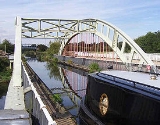
Stanley Ferry Aqueduct
Encyclopedia
Stanley Ferry Aqueduct was built between 1836 and 1839 to take the Aire and Calder Navigation
over the River Calder
in West Yorkshire
, England
. It is one of the earliest through arch bridges in the world and is considered to be the largest aqueduct executed in cast iron
.
Designed by George Leather Sr. and built by H. McIntosh, the aqueduct has a span of 50.3 metres (165 ft), a width of 7.3 metres (24 ft) and a depth of 2.6 metres (8.5 ft). It is still in use today, though an additional wider concrete aqueduct was constructed alongside in 1981 and the bridge was then renovated.
 Stanley Ferry is also the place where the Tom Pudding
Stanley Ferry is also the place where the Tom Pudding
tub boats were loaded with coal from local collieries between 1863 and 1985 and transported down to Goole
in long trains by canal.
The site is one of three historic ford
s crossing the River Calder near Wakefield
. Because the water was deepened for navigation a ferry became necessary, but was replaced by the first bridge in 1879.
Aire and Calder Navigation
The Aire and Calder Navigation is a river and canal system of the River Aire and the River Calder in the metropolitan county of West Yorkshire, England. The first improvements to the rivers above Knottingley were completed in 1704 when the Aire was made navigable to Leeds and the Calder to...
over the River Calder
River Calder, West Yorkshire
The River Calder is a river in West Yorkshire, in Northern England.The Calder rises on the green eastern slopes of the Pennines flows through alternating green countryside, former woollen-mill villages, and large and small towns before joining the River Aire near Castleford.The river's valley is...
in West Yorkshire
West Yorkshire
West Yorkshire is a metropolitan county within the Yorkshire and the Humber region of England with a population of 2.2 million. West Yorkshire came into existence as a metropolitan county in 1974 after the passage of the Local Government Act 1972....
, England
England
England is a country that is part of the United Kingdom. It shares land borders with Scotland to the north and Wales to the west; the Irish Sea is to the north west, the Celtic Sea to the south west, with the North Sea to the east and the English Channel to the south separating it from continental...
. It is one of the earliest through arch bridges in the world and is considered to be the largest aqueduct executed in cast iron
Cast iron
Cast iron is derived from pig iron, and while it usually refers to gray iron, it also identifies a large group of ferrous alloys which solidify with a eutectic. The color of a fractured surface can be used to identify an alloy. White cast iron is named after its white surface when fractured, due...
.
Designed by George Leather Sr. and built by H. McIntosh, the aqueduct has a span of 50.3 metres (165 ft), a width of 7.3 metres (24 ft) and a depth of 2.6 metres (8.5 ft). It is still in use today, though an additional wider concrete aqueduct was constructed alongside in 1981 and the bridge was then renovated.

Tom Pudding
Tom Pudding was the name given to the tub boats on the Aire and Calder Navigation, introduced in 1863 and used until 1985, which were a very efficient means of transferring and transporting coal from the open cast collieries of the South Yorkshire Coalfield near Stanley Ferry to the port of Goole,...
tub boats were loaded with coal from local collieries between 1863 and 1985 and transported down to Goole
Goole
Goole is a town, civil parish and port located approximately inland on the confluence of the rivers Don and Ouse in the East Riding of Yorkshire, England...
in long trains by canal.
The site is one of three historic ford
Ford (crossing)
A ford is a shallow place with good footing where a river or stream may be crossed by wading or in a vehicle. A ford is mostly a natural phenomenon, in contrast to a low water crossing, which is an artificial bridge that allows crossing a river or stream when water is low.The names of many towns...
s crossing the River Calder near Wakefield
Wakefield
Wakefield is the main settlement and administrative centre of the City of Wakefield, a metropolitan district of West Yorkshire, England. Located by the River Calder on the eastern edge of the Pennines, the urban area is and had a population of 76,886 in 2001....
. Because the water was deepened for navigation a ferry became necessary, but was replaced by the first bridge in 1879.

